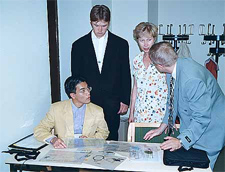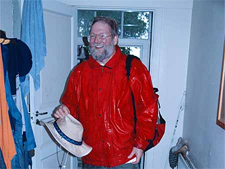Real Science
Conference News: July 1 - Real Science
High school students making university science
Myllyharju high school and University of Helsinki work together in GLOBE
Can high school students do "real science"? Can they cooperate with universities, professional scientists and researchers? In the GLOBE Program all this is possible, as the students, teachers and researchers at the Myllyharju High School and at the University of Helsinki have discovered. They have cooperated in organizing courses in environmental physics for the students in the second and third grades of high school.

Markku Kulmala, prof. and Jyrki Mäkelä Ph.D., from the department of physics told the students about the measurements and observations in the research station SMEAR II in Hyytiälä, Juupajoki. Liisa Pirjola Ph.Lic. also took part in the cooperation as a scientist. She has created LACOM, (Local Atmospheric Chemistry and Ozone Model) a computer model for research of the concentration of ozone and nitrogen oxides in the atmosphere. Two students, Huynh Xuan Phong and Lari Airaksinen researched the ozone concentration in the lowest layers of the atmosphere with LACOM. On Tuesday the 30th they presented their research at the GLOBE Learning Expedition. The participants of the conference will have an opportunity to learn LACOM in the GLOBE games in Nuuksio.
Teachers also learn from GLOBE
Matti Jutila, physics teacher and the principal of the Myllyharju high school, has mainly organized the courses. He is very interested in environmental physics and he thinks that it is important in environmental studies to make science and research work. So the students really feel they're doing something, helping the globe. The cooperation with a university allows the students to see a "real" scientist at work and gives the students guidance for their studies. Jutila says that he himself has learned almost everything he knows about chemistry and physics of the atmosphere during the cooperation.
Both Mr. Jutila and Mrs. Pirjola think that the cooperation has worked well. He says that Pirjola and Jyrki Mäkelä understand that students don't have a university level of knowledge and so they have paid attention to it. Pirjola thinks that high school students can make "real" science, they just need motivation and a guidance from a "real" scientist. The cooperation will continue. Matti Jutila says: "I easily recommend this way of working to every high school. In the universities there are many other faculties and in the faculties there are plenty of departments. I think every department should have a high school as a cooperation partner. So they would get a feel for future students!"
Conference author: Ilkka Järvinen
Predicting the future with GLOBE data and a computer model
Students and scientists worked together to research ozone concentration
LACOM is a computer program to predict future events on the global environment. Lari Airaksinen and Huynh Xuan Phong from Myllypuro high school combined the GLOBE data with the LACOM program, and were able to predict atmospheric changes around their school. They gave the first student presentation in the Learning Expedition on the subject on Tuesday, together with Prof. Markku Kulmala from University of Helsinki.
Mr. Airaksinen and Mr. Phong, together with Professor Kulmala and Ph.Lic. Liisa Pirjola, measured the contents of the air on a clear weather at the GLOBE research station in the Myllyharju high school. They fed the results in LACOM program, which predicted how the atmosphere, more specifically the ozone concentration in it would change. They were able to check the prediction with the data from research station SMEAR II in Hyytiälä, Juupajoki, and discovered it was correct. In the past magicians predicted the future using crystal balls and tea leaves. Now it's the job of scientists and computers.
Conference author: Ilkka Järvinen
Dr. Butler needs more students to gather data
Chief scientist hopes GLOBE will be passed on from generation to generation

A bearded man sits in the middle of the sunny yard at Nuuksio National Park, Finland looking thoughtful. Dr. Dixon Butler, Chief Scientist for the GLOBE Program, worries about the need for more students to make observations in the future in order to have a more complete global study. Maybe this bearded man with the Santa Claus face can heal the world a little bit with his contribution to GLOBE. The GLOBE's Chief Scientist's duties include checking GLOBE data for scientific accuracy and making sure all measurements are useful. Here in Helsinki, Dr. Butler is teaching soil pH and will be giving critical observations of GLOBE student's presentations.
Dr. Butler graduated from Harvard University, U.S, with a Masters in Physics and Chemistry. He later went on to Graduate School at Rice University where he majored in Space Physics and Astronomy. At Rice, he also researched the Ionosphere of the planet Venus. At Goddard Space Center, NASA, Dr. Butler did his research on predicting the depletion of the ozone layer. He also spent 16 months in fellowship at the U.S. Congress.
More schools, more students, more data
At the NASA Headquarters, Dr. Butler worked as a helper, working his way up the ladder. His most significant job was leading the planning for the future space program called Earth Observing System (EOS). As NASA began to downsize, he was forced to look else where for another project. Luckily, Dr. James Lawless came his way. Dr. Lawless described his experience with the GLOBE program as fantastic. This interested Dr. Butler and after brief lunch, Dr. Butler became Dr. Lawless' successor.
"I love GLOBE, the people are wonderful!", describes Dr. Butler. His greatest concern is that there are not enough GLOBE students to conduct an effective world-wide study. He hopes that GLOBE will become a part of everyone's daily routine, passing it on from generation to generation.
Conference authors: Kristin Marsh and Satu Kangas





